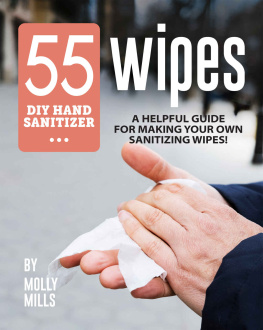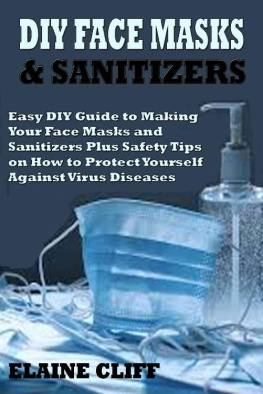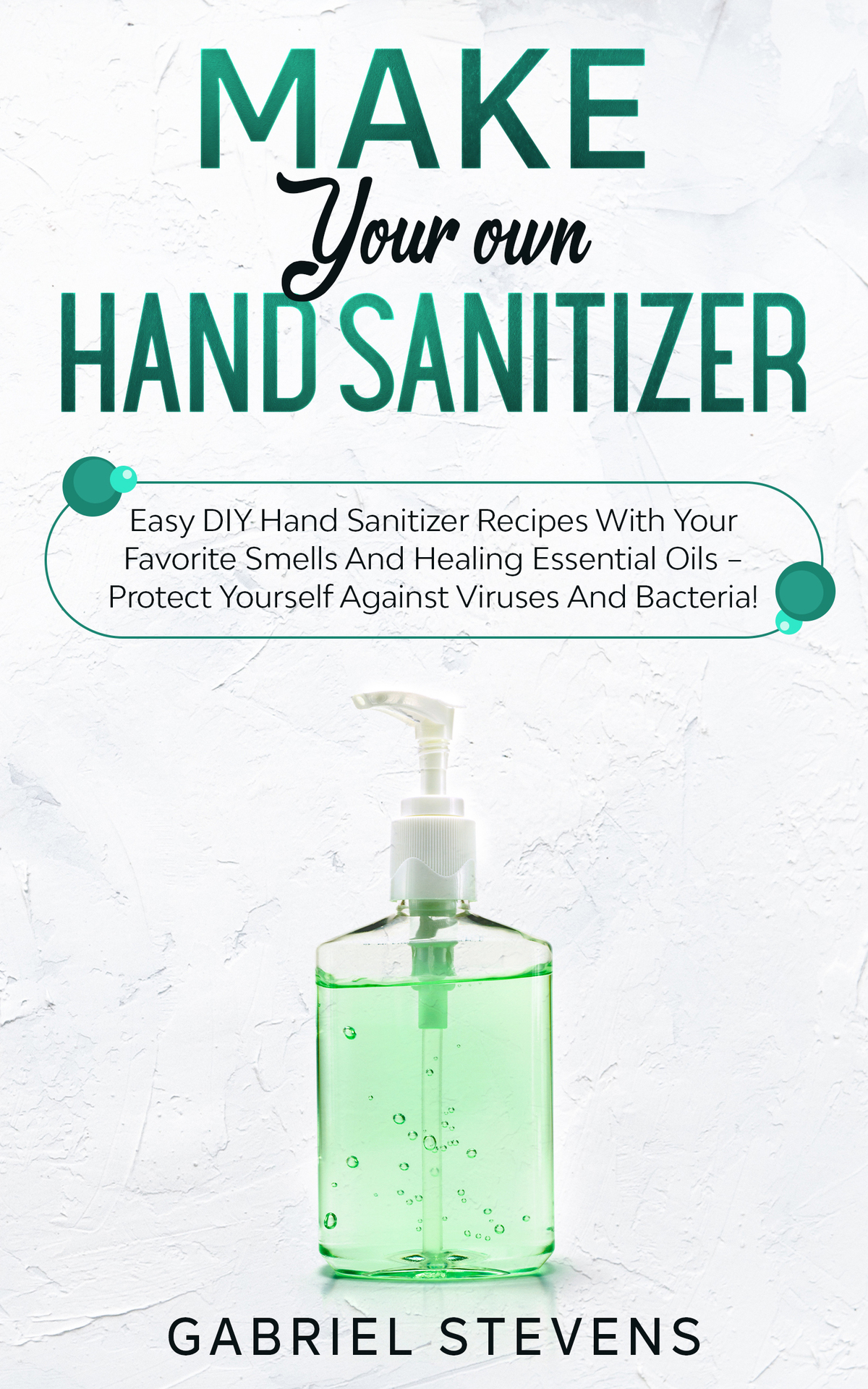MAKE YOUR OWN HAND SANITIZER
Easy DIY Hand Sanitizer Recipes With Your Favorite Smells And Healing Essential Oils Protect Yourself Against Viruses And Bacteria!
Gabriel Stevens
Copyright 2019 by Gabriel Stevens
All rights reserved.
This document is geared towards providing exact and reliable information with regards to the topic and issue covered. The publication is sold with the idea that the publisher is not required to render accounting, officially permitted, or otherwise, qualified services. If advice is necessary, legal or professional, a practiced individual in the profession should be ordered.
-From a Declaration of Principles which was accepted and approved equally by a Committee of the American Bar Association and a Committee of Publishers and Associations.
In no way is it legal to reproduce, duplicate, or transmit any part of this document in either electronic means or in printed format. Recording of this publication is strictly prohibited and any
storage of this document is not allowed unless with written permission from the publisher. All rights reserved.
The information provided herein is stated to be truthful and consistent, in that any liability, in terms of inattention or otherwise, by any usage or abuse of any policies, processes, or directions contained within is the solitary and utter responsibility of the recipient reader. Under no circumstances will any legal responsibility or blame be held against the publisher for any
reparation, damages, or monetary loss due to the information herein, either directly or indirectly.
Respective authors own all copyrights not held by the publisher.
The information herein is offered for informational purposes solely, and is universal as so. The presentation of the information is without contract or any type of guarantee assurance.
The trademarks that are used are without any consent, and the publication of the trademark is without permission or backing by the trademark owner. All trademarks and brands within this book are for clarifying purposes only and are the owned by the owners themselves, not affiliated with this document
Table of Contents
INTRODUCTION
L iquid hand sanitizers-mostly alcohol-based gels-have experienced an explosion in popularity over the last 10 years. If you've recently traveled by plane or set foot in a classroom in the US, chances are you've seen hand sanitizers in use.
Hand sanitizers do not act as a substitute for a comprehensive handwashing process. Alternatively, they are thought to bring some of the advantages of handwashing to customers when handwashing is not practical.
The association between the use of hand sanitizers and reduced disease has not been firmly established in epidemiological studies, but several laboratory studies indicate that hand sanitizers help prevent infections by killing transient pathogenic bacteria.
Handwashing and hand sanitizers eliminate microbial populations in various ways. Handwashing-whether performed with "antibacterial" soap or regular soap-physically eliminates microorganisms from the skin, practically washing the living microbes down the drain. Hand sanitizers eliminate microorganism levels by chemically destroying them, just as disinfectants kill germs on environmental surfaces.
The extent of the effect of handwashing is primarily a function of washing time and the use of soap. Washing hands without soap is much less efficient than that. The efficacy of hand sanitizers is highest when a large volume of product is applied to the hands. Applying a large volume of hand sanitizer guarantees an excess of the active ingredient and increases the duration of chemical action before the hand sanitizer evaporates.
Unlike disinfectants, which can be left virtually on the surface for up to 5 minutes, hand sanitizers must do their job within a limited period of time in order to produce the desired effect. The reality is that most people really won't tolerate wet hands for more than 30 seconds. Accordingly, the Microchem Laboratory claims that the contact time for laboratory testing of hand sanitizers should be 30 seconds, probably one minute in special cases.
Hand sanitizers may be motivated by a number of different active ingredients, but have you ever found that most hand sanitizers use alcohol as their active ingredient? This is largely the result of how they are governed.
What is hand hygiene?
H and hygiene is a way to clean one's hands that significantly reduces the possible pathogens (harmful microorganisms) on the hands. Hand hygiene is considered a primary measure to reduce the risk of infection transmission between patients and health care workers. Hand hygiene techniques include the use of alcohol-based hand rubs (containing 60%95% alcohol) and hand washing with soap and water. For surgical procedures, perform a hand wash before applying sterile gloves to the surgeon. In regular dental and non-surgical examinations, use alcohol-based hand rub or use water and clear or antimicrobial soaps that are unique to health care settings. Unless hands are visibly soiled (e.g., dirt, blood, body fluids), alcohol-based hand rub is preferred over soap and water in most clinical situations because it: is more effective than soap in killing potentially deadly germs on hands, Requires less time, It is more accessible than hand washing sinks, Reduces bacterial counts on hands and improves skin condition with less irritation and dryness.
Why is hand hygiene so important?
Hand hygiene is the most effective way to reduce germs and diseases in social care environments. Studies have shown that hands are the main carriers of infection.
Lack of hand hygiene and poor hand hygiene methods have led to many outbreaks of diarrhea among children and workers in community care settings. Consistently, adherence to good hand-hygiene practices has been shown to minimize disease transmission in child care and in school settings.
Hand hygiene contributes significantly to the health of patients. It is a quick, low-cost action to prevent the spread of many microbes that cause health-related infections (HAIs). Although hand hygiene is not the only measure to combat HAI, enforcement alone can dramatically improve patient safety, as there is much scientific evidence that HAI-causing microbes are most commonly distributed among patients in the hands of health care workers.
In fact, healthcare facilities that readily implement methods to improve hand hygiene are also more open to closer inspection of their infection control procedures in general. The effect of focusing on hand hygiene can therefore lead to an overall improvement in patient safety across the entire organization.
Finally, the identification of hand hygiene as the first pillar to endorse the WHO World Alliance for Patient Safety's Global Patient Safety Challenge shows its significance on the patient safety agenda.
When to Practice Hand Hygiene
Please perform hand hygiene in the following situations: before and after the care of each patient (e.g. before and after gloves).
Touching tools, machinery, fabrics, and other items that are likely to be tainted by blood, saliva, or respiratory secretions with bare hands.
Before you leave the dental treatment area.
When your hands are visibly soiled.
Before grinding and after removing gloves that are ripped, cut or punctured.
Upon arrival for the day, during breaks, when going from one party to another, whenever the hands may have been contaminated by contact with body fluid (e.g. by touching the inside of the diaper when testing the need for change, wiping the child's nose) and on leaving for the day, before and after Preparing food or beverages Eating, handling food, or feeding. Fingernails are supposed to be kept small.











